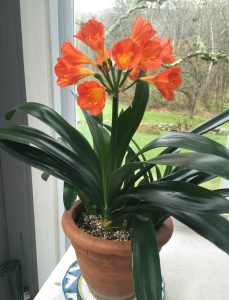designed for the way women work.

How To Get Flowering Houseplants Ready for Spring
Category: Houseplants, Indoor Gardening, Plant Ideas & Info, Presenting "The Curious Gardener", Spring Projects
It’s time to wake up your houseplants! As the days grow longer and the sun gets stronger, now is the time to wake up two of my favorite flowering houseplants, clivia miniata and agapanthus. Because it takes so much energy to produce a flower, they have been resting over the winter between bloom times.
Here are some techniques gardeners use to get them ready for spring.
Clivia miniata

Clivias are native to shady, subtropical woodland areas of eastern South Africa. In the wild, they go dormant during the dry part of the year when the environmental conditions are not suitable for the plant to grow. This rest time promotes the development of new buds.
To simulate these conditions in your home put your clivia in a cooler place (50-55 degrees is ideal) out of direct sunlight (not a south facing window) and deprive it of water for up to 12 weeks. Keep an eye on it and if you see the leaves wilting give it some water — but not a lot!
To stimulate buds at this time of year move the plant to a warmer spot (65-75 degrees) with bright, indirect light, and begin watering. Water only when the soil is dry, as clivias prefer to be kept on the dry side. The stem will lengthen and a bud will develop after 6 or more weeks. After your plant blooms fertilize monthly with a water soluble fertilizer.
Trouble Shooting: If your plant fails to produce new buds, as mine did last year, it may be that it was not cool or dry enough during the winter rest period. Also, keep in mind clivias like to be pot bound, so do not divide and repot the way you might with other bulbs. White Flower Farm, a longtime friend and supplier of Womanswork garden gloves, in their clivia miniata growing guide, recommends you repot every 3-5 years. To download the growing guide click here.
Also keep in mind that clivias are shade loving woodland plants, so they do not respond well when left in the hot sun. I learned the hard way when all the leathery leaves on mine got scorched one year.
Click here to visit The North American Clivia Society’s website, which has a wealth of information and links about clivias.
Lily of the Nile –Agapanthus africanus
Agapanthus, also known as Lily-of-the-Nile, or African Blue Lily, is a showy blue or white flowering perennial, native to South Africa, where it grows in the shade, under trees. It also experiences a dormant period during the winter months in the wild.
After overwintering your agapanthus indoors, in late winter or very early spring bring the plant into a warm area and water thoroughly. In a few weeks, new growth will emerge. It can be placed outdoors after danger of frost is over.

For more information about overwintering agapanthus, visit the Missouri Botanical Garden website by clicking here.


